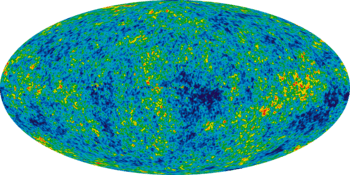Redshift-space distortions
| Part of a series on | |||
| Physical cosmology | |||
|---|---|---|---|
 | |||
|
Early universe
|
|||
|
Components · Structure |
|||
| |||
Redshift-space distortions are an effect in observational cosmology where the spatial distribution of galaxies appears squashed and distorted when their positions are plotted in redshift-space (i.e. as a function of their redshift) rather than in real-space (as a function of their actual distance). The effect is due to the peculiar velocities of the galaxies causing a Doppler shift in addition to the redshift caused by the cosmological expansion.
Redshift-space distortions (RSDs) manifest in two particular ways. The Fingers of God effect is where the galaxy distribution is elongated in redshift space, with an axis of elongation pointed toward the observer.[1] It is caused by a Doppler shift associated with the random peculiar velocities of galaxies bound in structures such as clusters. The large velocities that lead to this effect are associated with the gravity of the cluster by means of the virial theorem; they change the observed redshifts of the galaxies in the cluster. The deviation from the Hubble's law relationship between distance and redshift is altered, and this leads to inaccurate distance measurements.
Another, closely related effect is the Kaiser effect.[2] This time, the distortion is caused by the coherent motions of galaxies as they fall inwards towards the cluster center as the cluster assembles. Depending on the particular dynamics of the situation, the Kaiser effect usually leads not to an elongation, but an apparent flattening ("pancakes of God"), of the structure. It is a much smaller effect than the fingers of God, and can be distinguished by the fact that it occurs on larger scales.[3]
The previous effects are a result of special relativity, and have been observed in real data. There are additional effects come directly from general relativity. One and is called gravitational redshift distortion.[4] Gravitational redshift distortion comes about from the net gravitational redshift, or blueshift, that is acquired when the photon climbs out of the gravitational potential well of the distant galaxy and then falls into the potential well of the Milky Way galaxy. This effect will make galaxies at a higher gravitational potential than us appear slightly closer (generically: less massive galaxies), and galaxies at lower potential will appear farther away (more massive galaxies and near galaxy clusters).
The other effects of general relativity on clustering statistics are observed when the light from a background galaxy passes near, or through, a closer galaxy or cluster. These two effects go by the names integrated Sachs-Wolfe effect (ISW) and gravitational lensing.[5] For ISW, when a photon passes through a low area of gravitational potential it is 'protected' from the cosmological expansion of space, making the background galaxy appear closer. Gravitational lensing, unlike all of the previous effects, distorts the apparent position, and number, of background galaxies.
The RSDs measured in galaxy redshift surveys can be used as a cosmological probe in their own right, providing information on how structure formed in the Universe,[6] and how gravity behaves on large scales.[7]
References
Specific citations:
- ↑ Jackson, J.C. (1972). "A critique of Rees's theory of primordial gravitational radiation". Monthly Notices of the Royal Astronomical Society, 156, 1P-6P.
- ↑ Kaiser, N. (1987). "Clustering in real space and in redshift space". Monthly Notices of the Royal Astronomical Society, 227, 1-21.
- ↑ Cosmology Presentation
- ↑ McDonald, P. (2009). "Gravitational redshift and other redshift-space distortions of the imaginary part of the power spectrum" Journal of Cosmology and Astroparticle Physics, 11.
- ↑ Yoo, J. (2009). "Complete treatment of galaxy two-point statistics: Gravitational lensing effects and redshift-space distortions" Physical Review D, 79, 2.
- ↑ Percival, Will J.; White, Martin (11 February 2009). "Testing cosmological structure formation using redshift-space distortions". Monthly Notices of the Royal Astronomical Society. 393 (1): 297–308. arXiv:0808.0003
 . Bibcode:2009MNRAS.393..297P. doi:10.1111/j.1365-2966.2008.14211.x.
. Bibcode:2009MNRAS.393..297P. doi:10.1111/j.1365-2966.2008.14211.x. - ↑ Raccanelli, A.; Bertacca, D.; Pietrobon, D.; Schmidt, F.; Samushia, L.; Bartolo, N.; Dore, O.; Matarrese, S.; Percival, W. J. (25 September 2013). "Testing gravity using large-scale redshift-space distortions". Monthly Notices of the Royal Astronomical Society. 436 (1): 89–100. arXiv:1207.0500
 . Bibcode:2013MNRAS.436...89R. doi:10.1093/mnras/stt1517.
. Bibcode:2013MNRAS.436...89R. doi:10.1093/mnras/stt1517.
General references:
- Serjeant, Stephen; Open University (2010). Observational Cosmology. New York: Cambridge University Press. p. 110. ISBN 9780521157155.